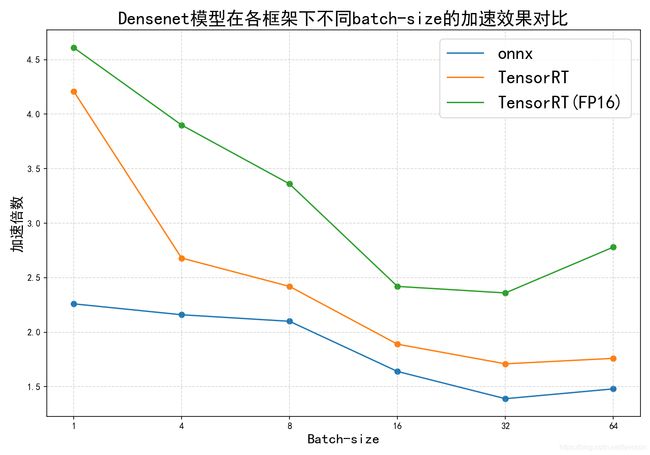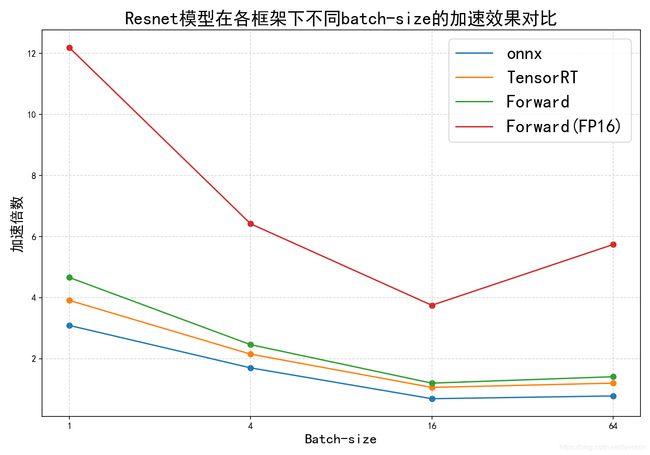TensorRT使用(Tensorflow/Keras/Pytorch)
本文旨在记录TensorRT使用情况,本人实测TensorRT加速Tensorflow,Keras,Pytorch模型,同时还对比了腾讯的Forward框架,当然Forward框架使用情况本篇文章不做记录。
环境(一):
(1)cuda:11.0
(2)cudnn:8.0.4
(3)TensorRT:7.2.1.6
(4)pycuda:2019.1.2
环境(二):
(1)cuda:10.0
(2)cudnn:7.6.3
(3)TensorRT:7.0.0.11
(4)pycuda:2019.1.2
一、TensorRT使用
(一)利用TensortRT加速Tensorflow模型
TensorRT官方样例:基于手写数字体识别MNIST数据集的Lenet5模型为例。
主体思想: Tensorflow->TensorRT(pb->uff)
具体流程:(1)下载MNIST数据集;(2)训练Lenet5模型;(3)将保存的模型(Lenet5.pb)转为Lenet.uff模型。
# 下载MNIST数据集
cd <TensorRT Path>/data/mnist
python download_pgms.py
# 开始训练Lenet5模型
cd <TensorRT Path>/samples/python/end_to_end_tensorflow_mnist/
python model.py
# 可得到模型Lenet5.pb
# 转换Lenet5.pb模型为Lenet5.uff模型
convert-to-uff ./models/Lenet5.pb ./models/Lenet5.uff
最后为TensorRT加载Lenet5.uff并加速推理代码。
# -*- coding:UTF-8 -*-
from random import randint
from PIL import Image
import numpy as np
import pycuda.driver as cuda
import pycuda.autoinit
import tensorrt as trt
import sys, os
# 导入/samples/python/common.py
sys.path.insert(1, os.path.join(sys.path[0], ".."))
import common
TRT_LOGGER = trt.Logger(trt.Logger.WARNING)
class ModelData(object):
MODEL_FILE = "lenet5.uff" # 模型路径
INPUT_NAME ="input_1" # 输入层名称 (convert-to-uff时可显示)
INPUT_SHAPE = (1, 28, 28) # 输入尺寸
OUTPUT_NAME = "dense_1/Softmax" # 输出层名称(convert-to-uff时可显示)
def build_engine(model_file):
# For more information on TRT basics, refer to the introductory samples.
with trt.Builder(TRT_LOGGER) as builder, builder.create_network() as network, trt.UffParser() as parser:
builder.max_workspace_size = common.GiB(1)
# Parse the Uff Network
parser.register_input(ModelData.INPUT_NAME, ModelData.INPUT_SHAPE)
parser.register_output(ModelData.OUTPUT_NAME)
parser.parse(model_file, network)
# Build and return an engine.
return builder.build_cuda_engine(network)
# Loads a test case into the provided pagelocked_buffer.
def load_normalized_test_case(data_paths, pagelocked_buffer, case_num=randint(0, 9)):
test_case_path = os.path.join(data_paths, str(case_num) + ".pgm")
# Flatten the image into a 1D array, normalize, and copy to pagelocked memory.
img = np.array(Image.open(test_case_path)).ravel()
np.copyto(pagelocked_buffer, 1.0 - img / 255.0)
return case_num
def main():
data_paths = './data'
model_path = os.environ.get("MODEL_PATH") or os.path.join(os.path.dirname(__file__), "models")
model_file = os.path.join(model_path, ModelData.MODEL_FILE)
with build_engine(model_file) as engine:
inputs, outputs, bindings, stream = common.allocate_buffers(engine)
with engine.create_execution_context() as context:
case_num = load_normalized_test_case(data_paths, pagelocked_buffer=inputs[0].host)
[output] = common.do_inference(context, bindings=bindings, inputs=inputs, outputs=outputs, stream=stream)
pred = np.argmax(output)
print("Test Case: " + str(case_num))
print("Prediction: " + str(pred))
if __name__ == '__main__':
main()
(二)利用TensortRT加速Keras模型
主体思想: Keras->ONNX->TensorRT(h5->onnx->engine)
以Densenet为例,该模型为数字识别模型。注: 本人动态输入(Batch-size, channels, height, width)为:(1, 1, 32, -1),动态输出(识别模型为19个类别)为:(1,-1,19)。
首先,待转换的模型需要包含图结构以及模型参数,利用keras2onnx工具,将keras模型转存为onnx模型;
import keras
import keras2onnx
import onnx
from tensorflow.keras.models import load_model
model = load_model('./models/densenet_num18.h5')
onnx_model = keras2onnx.convert_keras(model, model.name)
temp_model_file = './models/densenet_num18.onnx'
onnx.save_model(onnx_model, temp_model_file)
接下来有两种方法将onnx模型转换为TensorRT模型 :
法一:利用第三方工具onnx2trt将onnx模型转为uff模型。(目前因为动态输入问题未走通)
法二:利用TensorRT自带工具trtexec将onnx模型转为engine模型。(已走通固定尺寸输入)
cd <TensorRT Path>/bin
# 利用trtexec工具转换onnx模型为TensorRT可加载的engine模型
./trtexec \
--onnx=./keras/models/densenet_num18.onnx \
--shapes=the_input:1x32x148x1 \
--workspace=4096 \
--saveEngine=./keras/densenet_num18.engine
# 关于如何解决动态输入尺寸问题
# 将输入尺寸固定未每个不同batch_size进行保存engine,后续需修改--minShapes= \
# --optShapes= --maxShapes= 来进行动态尺寸输入。
# 如需16Bit量化,--fp16即可
最后加载engine模型并推理加速。
import os
import time
import numpy as np
import tensorrt as trt
from PIL import Image
import pycuda.driver as cuda
import pycuda.autoinit
class load_engine_inference(object):
def __init__(self, file_path):
self.engine = self.loadEngine2TensorRT(file_path)
def loadEngine2TensorRT(self, filepath):
G_LOGGER = trt.Logger(trt.Logger.WARNING)
# 反序列化引擎
with open(filepath, "rb") as f, trt.Runtime(G_LOGGER) as runtime:
engine = runtime.deserialize_cuda_engine(f.read())
return engine
def do_inference(self, img_path, do_print=False):
img = Image.open(img_path)
img = img.convert('L')
X = img.reshape([1, 32, width, 1])
input = X
# start_time = time.time()
output = np.empty((1, 18, 19), dtype=np.float32)
#创建上下文
self.context = self.engine.create_execution_context()
# 分配内存
d_input = cuda.mem_alloc(1 * input.size * input.dtype.itemsize)
d_output = cuda.mem_alloc(1 * output.size * output.dtype.itemsize)
bindings = [int(d_input), int(d_output)]
# pycuda操作缓冲区
self.stream = cuda.Stream()
# 将输入数据放入device
start_time = time.time()
self.pred_img(input, d_input, bindings, output, d_output)
end_time = time.time()
# 线程同步
self.stream.synchronize()
# 释放内存
self.context.__del__()
return output, end_time - start_time
def pred_img(self, input, d_input, bindings, output, d_output):
cuda.memcpy_htod_async(d_input, input, self.stream)
# 执行模型
self.context.execute_async(1, bindings, self.stream.handle, None)
# 将预测结果从从缓冲区取出
cuda.memcpy_dtoh_async(output, d_output, self.stream)
self.stream.synchronize()
img_path = '../tf/num_1_true.bmp'
engine_infer = load_engine_inference('./densenet_num18.engine')
## 第一次推理
res_1, use_time = engine_infer.do_inference(img_path)
print('first inference time: ', np.round((use_time)*1000, 2), 'ms')
法三:直接在代码中通过载入onnx模型并创建engine即可。(已走通动态输入)
# -*- coding:UTF-8 -*-
# @Time : 2021/5/24
# @Author : favorxin
# @Func : 利用TensorRT对ONNX模型进行加速的推理代码
import os
import sys
import time
import math
import copy
import numpy as np
import tensorrt as trt
import pycuda.autoinit
import pycuda.driver as cuda
from PIL import Image
### 正常TensorRT定义变量
TRT_LOGGER = trt.Logger(trt.Logger.INFO)
a = (int)(trt.NetworkDefinitionCreationFlag.EXPLICIT_BATCH)
EXPLICIT_BATCH = 1 << (int)(trt.NetworkDefinitionCreationFlag.EXPLICIT_BATCH)
device = 'cuda:0'
### 分配内存不超过30G
def GiB(val):
return val * 1 << 30
### 读取onnx模型并构建engine
def build_engine(onnx_path, using_half,engine_file,dynamic_input=True):
trt.init_libnvinfer_plugins(None, '')
with trt.Builder(TRT_LOGGER) as builder, builder.create_network(EXPLICIT_BATCH) as network, trt.OnnxParser(network, TRT_LOGGER) as parser:
builder.max_batch_size = 1 # always 1 for explicit batch
config = builder.create_builder_config()
config.max_workspace_size = GiB(4) # 设置4G的创建engine的显存占用
if using_half:
config.set_flag(trt.BuilderFlag.FP16) # 半精度FP6
# Load the Onnx model and parse it in order to populate the TensorRT network.
with open(onnx_path, 'rb') as model:
if not parser.parse(model.read()):
print ('ERROR: Failed to parse the ONNX file.')
for error in range(parser.num_errors):
print (parser.get_error(error))
return None
### 设置动态输入尺寸设置三个尺寸,依次最小尺寸,最佳尺寸,最大尺寸。
### (Batch-size, channel, height, width)输入最好按照该顺序,本人尝试通道数放最后未走通,动态输入会报错。
if dynamic_input:
profile = builder.create_optimization_profile();
profile.set_shape("the_input", (1,1,32,80), (1,1,32,148), (1,1,32,250))
config.add_optimization_profile(profile)
return builder.build_engine(network, config)
### 为输入,输出分配内存
def allocate_buffers(engine, is_explicit_batch=False, input_shape=None, output_shape=18):
inputs = []
outputs = []
bindings = []
class HostDeviceMem(object):
def __init__(self, host_mem, device_mem):
self.host = host_mem
self.device = device_mem
def __str__(self):
return "Host:\n" + str(self.host) + "\nDevice:\n" + str(self.device)
def __repr__(self):
return self.__str__()
for binding in engine:
dims = engine.get_binding_shape(binding)
### 此处是动态输入和动态输出所需设置的输入和输出尺寸大小。
if dims[-1] == -1 and len(dims) == 4:
assert (input_shape is not None)
dims[-1] = input_shape
elif dims[-2] == -1 and len(dims) == 3:
assert (output_shape is not None)
dims[-2] = output_shape
size = trt.volume(dims) * engine.max_batch_size # 设置推理所需的最大batch-size.
dtype = trt.nptype(engine.get_binding_dtype(binding))
# 分配内存
host_mem = cuda.pagelocked_empty(size, dtype)
device_mem = cuda.mem_alloc(host_mem.nbytes)
bindings.append(int(device_mem))
if engine.binding_is_input(binding):
inputs.append(HostDeviceMem(host_mem, device_mem))
else:
outputs.append(HostDeviceMem(host_mem, device_mem))
return inputs, outputs, bindings
### 输入图片的预处理,输出预处理过后图片以及该图片预处理过后的宽。
def preprocess_image(imagepath):
img = Image.open(imagepath)
img = img.convert('L')
width, height = img.size[0], img.size[1]
scale = height * 1.0 / 32
new_width = int(width / scale)
img = img.resize([new_width, 32], Image.ANTIALIAS)
img = np.array(img).astype(np.float32) / 255.0 - 0.5
X = img.reshape([1, 1, 32, new_width])
return X, new_width
### 根据输入图片的宽度计算最终模型输出的尺寸大小。(因本人模型为动态输入,动态输出,故需计算输出尺寸大小,并分配输出的内存占用)。
def compute_out_shape(input_shape):
x2 = input_shape
x2_ft = math.floor((x2 - 5 + 2 * 2) / 2) + 1
for i in range(2):
x2_ft = int(x2_ft/2) if x2_ft % 2 == 0 else int((x2_ft-1)/2)
return x2_ft
### 根据engine推理代码
def profile_trt(engine, imagepath, batch_size):
assert (engine is not None)
### 确定模型输出尺寸,从而为输入输出分配内存
input_image, input_shape = preprocess_image(imagepath)
output_shape = compute_out_shape(input_shape)
segment_inputs, segment_outputs, segment_bindings = allocate_buffers(engine, True, input_shape, output_shape)
stream = cuda.Stream()
with engine.create_execution_context() as context:
context.active_optimization_profile = 0
origin_inputshape = context.get_binding_shape(0)
# 本人此处输入图片的宽度为动态的,故最后一位为动态的,并根据输入图片尺寸进行固定
if (origin_inputshape[-1] == -1 and len(origin_inputshape) == 4):
origin_inputshape[-1] = input_shape
context.set_binding_shape(0, (origin_inputshape))
# 本人此处模型输出结果为动态 的,为倒数第二位为动态的,可以根据输入图片的宽度确定
elif (origin_inputshape[-2] == -1 and len(origin_inputshape) == 3):
origin_inputshape[-2] = output_shape
context.set_binding_shape(0, (origin_inputshape))
segment_inputs[0].host = input_image
start_time = time.time()
[cuda.memcpy_htod_async(inp.device, inp.host, stream) for inp in segment_inputs]
context.execute_async(bindings=segment_bindings, stream_handle=stream.handle)
[cuda.memcpy_dtoh_async(out.host, out.device, stream) for out in segment_outputs]
stream.synchronize()
use_time = time.time() - start_time
infer_out = [out.host for out in segment_outputs]
results = infer_out[0]
return results, use_time
if __name__ == '__main__':
onnx_path = './onnx_models/densenet_num18_rmnode1.onnx'
usinghalf = True
batch_size = 1
imagepath = './data/num_5_true.bmp'
engine_file = 'densenet_num18_t_dynamic.engine'
init_engine = True
load_engine = True
### 初始化并创建engine,根据onnx模型创建engine,该步骤较为费时,故正常会将engine保存下来,方便后期推理。
if init_engine:
trt_engine = build_engine(onnx_path, usinghalf, engine_file, dynamic_input=True)
print('engine built successfully!')
with open(engine_file, "wb") as f:
f.write(trt_engine.serialize())
print('save engine successfully')
### 利用上方创建的engine进行推理。平时推理时可以将init_engine设为False,因为engine已保存。
if load_engine:
trt.init_libnvinfer_plugins(None, '')
with open(engine_file, "rb") as f, trt.Runtime(TRT_LOGGER) as runtime:
trt_engine = runtime.deserialize_cuda_engine(f.read())
trt_result, use_time = profile_trt(trt_engine, imagepath, batch_size)
print(trt_result)
(三)利用TensortRT加速Pytorch模型
主体思想: Pytorch->onnx->TensorRT(pth->onnx->engine)
以图片二分类模型resnet18为例,输入为(1,3,224,224),输出为(1,2)。
首先,利用Pytorch自带onnx转换工具,将Pytorch模型转换为onnx模型;
import torch
resnet_model_path = './models/resnet_state.pth'
model = ResNet()
model.load_state_dict(torch.load(resnet_model_path))
model.eval()
model.cuda()
## 转换ONNX模型并保存
export_onnx_file = "./models/resnet18.onnx"
x=torch.onnx.export(model, # 待转换的网络模型和参数
torch.randn(1, 3, 224, 224, device='cpu'), # 虚拟的输入,用于确定输入尺寸和推理计算图每个节点的尺寸
export_onnx_file, # 输出文件的名称
verbose=False, # 是否以字符串的形式显示计算图
input_names=["input"]+ ["params_%d"%i for i in range(120)], # 输入节点的名称,这里也可以给一个list,list中名称分别对应每一层可学习的参数,便于后续查询
output_names=["output"], # 输出节点的名称
opset_version=10, # onnx 支持采用的operator set
do_constant_folding=True, # 是否压缩常量
dynamic_axes={"input":{0: "batch_size"}, "output":{0: "batch_size"},} #设置动态维度,此处指明input节点的第0维度可变,命名为batch_size
)
然后利用TensorRT自带工具trtexec将onnx模型转化为engine模型。(同keras模型转engine模型一致)
cd <TensorRT Path>/bin
# 利用trtexec工具转换onnx模型为TensorRT可加载的engine模型
./trtexec \
--onnx=./torch/models/resnet18.onnx \
--shapes=input:1x3x224x224 \
--workspace=4096 \
--saveEngine=./torch/resnet18.engine
推理代码同keras推理代码一致。
二、实验结果
Keras:Densenet识别模型在2080Ti上的性能对比:
| 参数 | 模型 | 速度(ms) | 加速比 | 显存占用(MB) |
|---|---|---|---|---|
| batch_size=1 | keras | 5.72 | 1 x | 2737 |
| onnx | 2.53 | 2.26 x | 716 | |
| TensorRT | 1.36 | 4.21 x | 776 | |
| TensorRT(FP16) | 1.24 | 4.61 x | 774 | |
| batch_size=4 | keras | 5.73 | 1 x | 2847 |
| onnx | 2.65 | 2.16 x | 722 | |
| TensorRT | 2.14 | 2.68 x | 798 | |
| TensorRT(FP16) | 1.47 | 3.9 x | 620 | |
| batch_size=8 | keras | 6.25 | 1 x | 2959 |
| onnx | 2.98 | 2.1 x | 732 | |
| TensorRT | 2.58 | 2.42 x | 612 | |
| TensorRT(FP16) | 1.86 | 3.36 x | 624 | |
| batch_size=16 | keras | 6.26 | 1 x | 3179 |
| onnx | 3.81 | 1.64 x | 796 | |
| TensorRT | 3.32 | 1.89 x | 824 | |
| TensorRT(FP16) | 2.59 | 2.42 x | 630 | |
| batch_size=32 | keras | 8.64 | 1 x | 3369 |
| onnx | 6.23 | 1.39 x | 908 | |
| TensorRT | 5.06 | 1.71 x | 700 | |
| TensorRT(FP16) | 3.66 | 2.36 x | 646 | |
| batch_size=64 | keras | 16.43 | 1 x | 3949 |
| onnx | 11.1 | 1.48 x | 1164 | |
| TensorRT | 9.36 | 1.76 x | 770 | |
| TensorRT(FP16) | 5.9 | 2.78 x | 842 |
Resnet18分类模型在2080Ti上的性能对比
| 参数 | 模型 | 速度(ms) | 加速比 | 显存占用(MB) |
|---|---|---|---|---|
| batch_size=1 | pytorch | 6.34 | 1 x | 927 |
| onnx | 2.05 | 3.09 x | 1035 | |
| TensorRT | 1.62 | 3.91 x | 887 | |
| Forward | 1.36 | 4.66 x | 2749 | |
| Forward(FP16) | 0.52 | 12.19 x | 2749 | |
| batch_size=4 | pytorch | 6.16 | 1 x | 1187 |
| onnx | 3.62 | 1.7 x | 1115 | |
| TensorRT | 2.87 | 2.15 x | 1036 | |
| Forward | 2.5 | 2.46 x | 2785 | |
| Forward(FP16) | 0.96 | 6.42 x | 2785 | |
| batch_size=16 | pytorch | 8.62 | 1 x | 2537 |
| onnx | 12.50 | 0.69 x | 1495 | |
| TensorRT | 8.17 | 1.06 x | 910 | |
| Forward | 7.16 | 1.2 x | 2877 | |
| Forward(FP16) | 2.3 | 3.75 x | 2877 | |
| batch_size=64 | pytorch | 38.04 | 1 x | 6537 |
| onnx | 48.80 | 0.78 x | 3071 | |
| TensorRT | 31.61 | 1.2 x | 1421 | |
| Forward | 26.99 | 1.41 x | 3881 | |
| Forward(FP16) | 6.63 | 5.74 x | 3881 |




三、总结
目前基于识别模型,TensorRT加速倍数在4倍以上,而16bit量化对于Batch-size较大时提升更为明显。对比Batch-size,随着batch-size的增大,tensorrt和onnx加速效果会逐步降低到1.5 ~ 2倍左右。而16Bit压缩的加速效果也会降低,逐步减小到2.6 ~ 3倍左右。
参考文章:
(1)https://zhuanlan.zhihu.com/p/64053177
(2)https://www.jianshu.com/p/3c2fb7b45cc7
(3)https://github.com/onnx/onnx-tensorrt/issues/638
(4)https://zhuanlan.zhihu.com/p/299845547